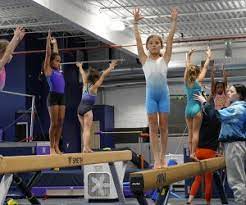What Are the Gymnastics Levels for Kids?
Gymnastics for kids is structured through a clear, progressive level system. These levels help coaches, parents, and young gymnasts track development, from basic coordination to advanced competitive routines. In Australia, most recreational and competitive pathways follow the Australian Levels Program (ALP), which includes ten progressive levels designed for artistic gymnastics, plus other pathways like KinderGym and TeamGym.
Here’s a simple breakdown:
- Beginner levels (1–3): Focus on foundational strength, coordination, flexibility, and basic movement.
- Intermediate levels (4–6): Introduce more technical skills, routines, and controlled apparatus usage.
- Advanced levels (7–10): Prepare gymnasts for competitions, demanding precision, discipline, and artistry.
This guide walks you through the structure, what kids can expect at each stage, and how families can support their journey.
Why Are Gymnastics Levels Important?
Each level in gymnastics for kids acts as a milestone, helping them develop physically and emotionally. Kids aren’t just learning how to flip—they’re building life skills like goal-setting, resilience, and teamwork. Progressing through levels also ensures that children train safely, with skills taught in the right order and intensity.
Many clubs, such as those aligned with Gymnastics Australia, use level badges or certificates to recognise each milestone—an approach rooted in Cialdini’s principle of consistency: when kids see their progress, they’re more motivated to continue.
How Does a Child Start at Level 1?
Most kids begin their gymnastics journey between ages 4 and 7, starting with KinderGym or a recreational Level 1 class. These sessions focus on:
- Balance and basic locomotion (e.g., skipping, hopping)
- Hand-eye coordination
- Body awareness and safe landings
- Social interaction and fun!
Classes are designed to be engaging and non-intimidating, using foam pits, mini beams, and music to keep children active and excited.
What Happens in Levels 2 and 3?
Once kids are comfortable with the basics, they move into Levels 2 and 3. These levels introduce more structure:
- Skill focus: Forward rolls, cartwheels, handstands against the wall
- Apparatus familiarity: Low bars, beginner beam walking, springboard jumps
- Routine practice: Short sequences that start to mimic competition-style performances
At this point, kids begin building muscle memory, making these levels crucial for long-term development.
What Do Intermediate Gymnastics Levels Include?
Levels 4 through 6 are where things get exciting—and more challenging. Kids in these levels start to polish technique and develop strength and grace under pressure. Coaches begin refining form, timing, and control.
Highlights of these levels include:
- Vaults with run-up and springboard technique
- Casts and back hip circles on uneven bars
- Beam routines with mounts, turns, and dismounts
- Floor tumbling passes (round-offs, walkovers, leaps)
These levels often involve intra-club or inter-club competitions. Here, social proof plays a role—seeing peers perform boosts confidence and motivation.
What About Competitive Levels 7–10?
Not all kids reach these advanced levels, and that’s perfectly fine. Levels 7–10 are designed for those who are committed to gymnastics as a sport. Training becomes more intense, often requiring multiple sessions per week.
Advanced routines incorporate:
- Aerial cartwheels and handsprings
- Flyaways and kips on bars
- Full turns and leaps on beam
- Dynamic choreography on the floor
Kids at these levels usually participate in state or national events. While competition is part of the journey, the focus remains on self-improvement and personal achievement.
Are There Other Gymnastics Programs for Kids?
Yes! Besides the traditional levels pathway, kids can also explore:
- KinderGym: Play-based learning for ages 1–5, focusing on movement and parent interaction.
- TeamGym: Group routines with synchronised movements—great for kids who thrive in team environments.
- FreeG: A freestyle gymnastics style for older kids and teens that blends parkour, flips, and creativity.
These alternatives offer flexibility for different personalities and preferences, helping more children enjoy the benefits of gymnastics without pressure.
How Can Parents Support Their Child’s Gymnastics Progress?
Here are a few easy ways to stay engaged:
- Encourage consistency: Regular attendance helps with skill retention.
- Celebrate milestones: Whether it’s a new skill or a move up a level, make it a big deal.
- Foster fun, not pressure: Let kids lead their journey—whether they love competition or simply enjoy movement.
- Be present: Watching sessions, chatting with coaches, and understanding the terminology helps you stay involved.
Support also means trusting the process—gymnastics takes time, and progress doesn’t always look linear.
FAQs: Gymnastics for Kids
What age should my child start gymnastics?
Most children begin between ages 3 and 6 in a beginner or KinderGym class. The earlier they start, the more comfortable they become with body movement and coordination.
How do coaches decide when a child should move up a level?
Coaches assess skill mastery, confidence, and consistency. They won’t push a child up unless they can perform current-level skills safely and reliably.
Is gymnastics safe for kids?
Yes—when taught by certified coaches in a structured environment. Progression through levels ensures children learn appropriate skills for their age and ability.
Final Thoughts
Gymnastics for kids is more than flips and floor routines—it’s a path to physical literacy, confidence, and lifelong friendships. Whether your child is just starting or climbing toward competitive levels, understanding the gymnastics pathway helps you guide and support them meaningfully.
For families exploring recreational pathways, programs like YMCA Leisure City Gymnastics offer great options for developing strength, skill, and self-esteem in a fun setting.

